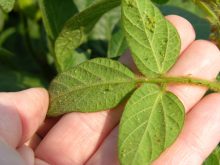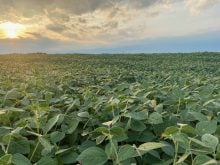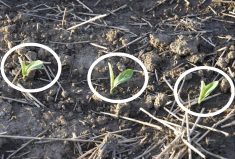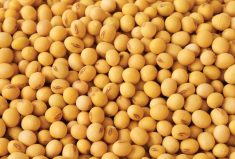Sudden death syndrome (SDS), a common disease found in soybeans, is showing up across the province but should be of limited yield impact this year due to its late onset.
“We have seen a higher instance of sudden death syndrome than most years. We had quite a bit of it in 2018. Last year we didn’t see much and it seems to be back again,” says Bob Thirlwall, agronomist with Bayer Crop Science. “I think the heavy rainfalls in August have brought it on this year.”
Read Also

Senft to step down as CEO of Seeds Canada
Barry Senft, the founding CEO of the five-year-old Seeds Canada organization is stepping down as of January 2026.
Why it matters: Sudden death syndrome is known as one of the diseases with the highest yield effect on soybeans. Late onset and proper management can help to limit the damage from the disease.
Sudden death syndrome is often initiated by fusarium root rot as it develops from the fungus fusarium virguliforme.
It begins as small yellow patches between the leaf veins.
As it progresses the yellow blotches enlarge and coalesce to form large patches of dead tissue. The midvein and lateral veins remain green making it one of the easier soybean diseases to identify.
These foliar symptoms of sudden death syndrome are not known to appear until after the soybean has flowered, from R2 to R7 staging, full bloom to beginning maturity.
Thirlwall says that because the disease has arrived later this year, at R6, there may not be that much of a yield impact.
“At R6 (when the green seeds fill the pod at one of the top four main stem nodes) those pods are fairly well developed and all the beans are touching. When the disease comes in this late it shouldn’t be too much of an impact.”
Ilevo seed treatment, with active ingredient fluopyram, helps to also delay this onset, lowering the yield impact of the disease.
“If sudden death syndrome comes in on Aug. 1, when the beans are at R4, then you can have 50 per cent yield impact in those little pockets of the field. But if we can delay that with Ilevo such as (SDS with delayed onset) did this year naturally when beans are R5 or R6 then you have a much smaller yield impact.”
To further manage the disease, seed variety also plays a large role.
Choosing varieties with sudden death syndrome resistance is important. Presence of soybean cyst nematode is correlated to sudden death syndrome, so its important to choose resistant varieties.
Thirlwall says that through his experience when testing the soil in areas with heavy sudden death syndrome, high soybean cyst nematodes levels are found.
“I checked a field south of Chatham with 12,000 soybean cyst nematodes and that is definitely a contributing factor (to the sudden death syndrome).”
The syndrome is known to occur more commonly in dense areas of the fields with a heavy canopy, advanced growth stages, and little air movement.
Thirlwell says it also more commonly starts in lighter soils and on sandy knolls.
“I think that is a direct correlation to the soybean cyst pressure in that field. If you have a field with a history of sudden death syndrome and high soybean cyst nematode pressure, then those are the fields to take advantage of the seed treatments to help protect against SDS.”















